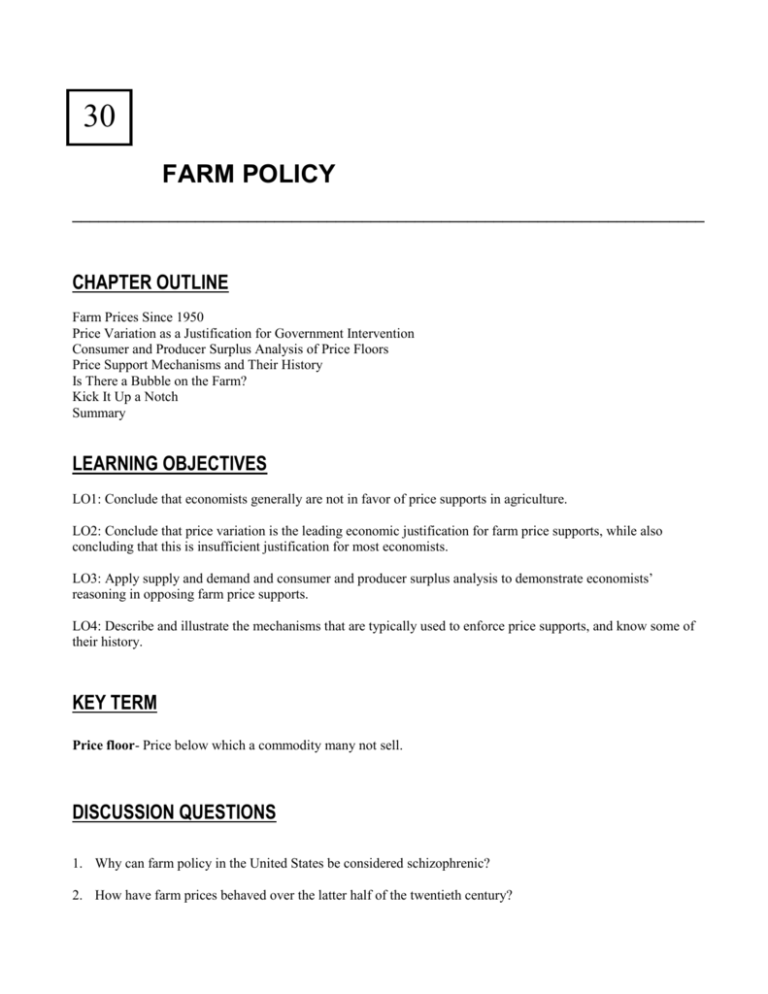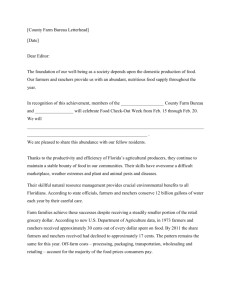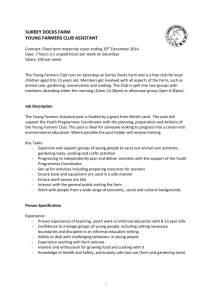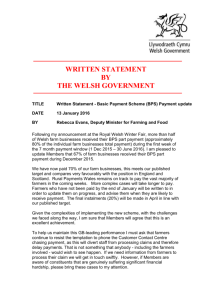CHAPTER 1
advertisement

30 4 FARM POLICY ________________________________________________________________________ CHAPTER OUTLINE Farm Prices Since 1950 Price Variation as a Justification for Government Intervention Consumer and Producer Surplus Analysis of Price Floors Price Support Mechanisms and Their History Is There a Bubble on the Farm? Kick It Up a Notch Summary LEARNING OBJECTIVES LO1: Conclude that economists generally are not in favor of price supports in agriculture. LO2: Conclude that price variation is the leading economic justification for farm price supports, while also concluding that this is insufficient justification for most economists. LO3: Apply supply and demand and consumer and producer surplus analysis to demonstrate economists’ reasoning in opposing farm price supports. LO4: Describe and illustrate the mechanisms that are typically used to enforce price supports, and know some of their history. KEY TERM Price floor- Price below which a commodity many not sell. DISCUSSION QUESTIONS 1. Why can farm policy in the United States be considered schizophrenic? 2. How have farm prices behaved over the latter half of the twentieth century? 2 Chapter 30 3. What arguments are put forth in support of government intervention in agriculture? 4. Why are most economists against price supports in agriculture? 5. Why is there a deadweight loss to society associated with price floors? 6. What would happen in the agricultural market if price supports were taken away? 7. What are the problems with the Eau Claire Rule? 8. Describe three mechanisms of price supports. 9. Briefly outline the history of price supports in the United States. 10. Why is it so difficult to totally eliminate government intervention in agriculture? 11. Why do the prices of corn and soybeans tend to move together? THE WEB-BASED QUESTION The following websites discuss a number of current issues related to agriculture. One website is the U.S. Department of Agriculture website that contains a number of monthly news releases on various segments of the agriculture sector. The other websites examine biobased products and sustainable agricultural policy. Use the following sites to answer the related questions: Part I. www.ars.usda.gov/aboutus/docs.htm?docid=1800&page=1 What are some critical external factors that must be addressed by public policy makers in agriculture? Part II. www.hort.purdue.edu/newcrop/proceedings1999/v4-130b.html www.sustainableagriculture.net www.ucsusa.org/food_and_environment/sustainable_food/new-policies-for-a-new-agriculture.html Discuss the move toward sustainable agriculture and the new biobased products. Farm Policy 3 ANSWERS TO STUDY QUESTIONS SUGGESTED ANSWERS TO THE DISCUSSION QUESTIONS 1. Farm policy in the United States has been considered schizophrenic because sometimes farmers are depicted as strong independent men and women who simply need the government to stay out of their way, and at other times they are depicted as desperate victims in need of help. In speeches, politicians speak about family farms with considerable reverence and refer to them with reverence. 2. Since 1950, farm prices have fluctuated considerably. Figure 30.1 shows farm prices of five commodities (corn, beef, hog, soybeans and milk) relative to their 1982 levels. Using 1982 as the base year, there was a sharp jump in commodity prices in the early 1970s. Prices of all the five products were higher in 2004 than in 1950, but two of the five were lower in 2004 than in 1982. Since overall inflation was 89 percent from 1982 to 2004, farmers producing these crops would have experienced a 53 percent loss in real income. Hog prices fared the worst between 1998 and 2000, yielding at times less than 45 percent of their 1982 levels. 3. The arguments in favor of government intervention in agriculture are as follows: Price variability makes farming, especially for small farms, a very risky occupation. There is supply uncertainty, which comes from uncontrollable factors, such as the weather, diseases, and insect damage. There is demand uncertainty that comes from quantities of goods foreigners will buy depending in part on supply conditions in other nations. Farming is still considered sacrosanct and politicians are strongly tempted to help farmers. 4. Most economists are against price supports because they feel that farmers can protect themselves against uncontrollable factors ahead of time with two forms of insurance: commodity options and crop insurance. 5. When there is a loss of consumer and producer surplus, there is a deadweight loss. In a free market (without price supports), consumer surplus and producer surplus are maximized (see Figure 30.2 in your text), where consumer surplus is P*AC and producer surplus P*CH. In order to raise farmers’ incomes, the government sets a price floor, PFLOOR. This results in a smaller combined consumer and producer surplus (PFLOORAB plus HPFLOORBG) as compared to the free market situation described previously. This loss of consumer and producer surplus is the deadweight loss, GBC. 6. Without price supports, farmers may opt to leave the industry completely if the rate of return to farming is too low; or there are some farmers who may prefer to continue farming as the lack of a boss outweighs the lower income they get. 4 Chapter 30 7. The Eau Claire Rule sets the minimum price for milk depending on how far the dairy farmers are from this Wisconsin city. The further away, the larger the subsidy. Problems with this rule are: Distant farms are encouraged to farm dairy, whether or not they are productive, because they are guaranteed a high minimum price. Consumers in the distant city also end up paying high prices. Even if the most efficient producer is close to Eau Claire, they are not guaranteed the high price in the distant city. 8. Three mechanisms of price support are: Raise the price above the equilibrium and limit the amount the farmer can produce. Either pay farmers not to produce as much as they might want or pay the farmer not to farm at all. An expensive option is to let farmers grow all they want and either pay them the difference between the market price and the price floor, or buy up whatever was not purchased by consumers. The government can either let the surplus spoil, give it away, or store it. 9. The following is a brief history of price supports in the United States: Price supports for agriculture grew out of the depression of the 1930s, when prices fell rapidly, leaving many farmers bankrupt. Politicians put price floors on many products, mostly dairy. The government stored a lot of products and in the middle of the 1982 recession, there was enough dairy and cheese to give to many poor people. In the middle 1980s, the Reagan administration tried to reduce the cost of subsidies by limiting supply and giving away government excess stocks of grain and dairy products. Farmers were offered payments not to farm. The 1996 Freedom to Farm Act began the long phase of practices leading away from agricultural supports. Current policy restricts output instead of buying up excess produce. Many thousands of farmers are paid billions of dollars not to farm many millions of acres. By 2002, the United States was supposed to exist without supports for milk or grain, but supports continued in 2005. 10. It is very difficult to totally eliminate government intervention in agriculture because farming is still considered sacrosanct and politicians feel very tempted to help farmers. 11. Corn and soybean prices mirror one another, because they are alternative outputs for farmers. Farm Policy 5 SUGGESTED ANSWER TO THE WEB-BASED QUESTION Part I. The Agricultural Research Service (ARS) is the principal in-house research agency of the U.S. Department of Agriculture. According to this department, the future of American agriculture lies on its ability to respond to critical external factors. Some of the factors identified by the ARS are as follows: Globalization: to remain competitive, the food and agricultural sector needs to take into account major changes in worldwide competitive markets involving population growth; evolving diets; diseases and pests that are transferred across national boundaries; and international controversies over the use of biotechnology. Information Access and Communication: the explosion in information and communication technology offer benefits and opportunities for all those engaged in the American food and agricultural sector. Workforce: the public sector needs to recruit retain and encourage students (including women and minorities) in science and technology to tap the nation’s potential to support dwindling employment in agriculture. Technology: advances in technology, such as bioengineering, precision agricultural sensing, and decision modeling, can lead to agricultural production that is in harmony with the environment, and can make food supply safe. When there is also concern about genetically modified organisms (GMOs), new rapid detection technologies spot unsafe food supplies. Changing Demographics: there will be increased demand for US agricultural products from growing global populations, but U.S. agriculture has to become more efficient in order to compete with increased competition from other countries. Changing Structure of Agriculture: during the last decades of the 20th century, farms and production methods were produced on fewer, larger firms, and became more specialized. Consumer preferences, new technology, and global markets affect farmers, processors, marketers and consumers. Congressional Support: in order to continue research, the ARS scientific workforce requires Congressional support. There have been large declines in the number of scientists over the last 25 years. Drug-Free Workplace: the ARS seeks compliance with a drug-free workplace. Source: www.ars.usda.gov/aboutus/docs.htm?docid=1800&page=1 Part II. Section 9002 of the 2002 farm bill (Farm Security and Rural Investment Act of 2002) established a Federal biobased products purchasing program, which went into effect in January 2005. 6 Chapter 30 Biobased products are non-food commercial or industrial products derived from “environmentally friendly” agricultural (plant, animal and marine-based) and forestry sources. To support this initiative, the U.S. Department of Agriculture established a wholly-owned corporation, the Alternative Agricultural Research and Commercialization Corporation (AARC), which functions as a venture capital firm, and invests in companies that research, develop and produce commercially viable biobased commodities. The Office of the Federal Environment Executive is charged with promoting sustainable environmental stewardship throughout the Federal government. Agriculture is only one aspect of their scope of activities. Others include education, social, health and related fields. They are supporting the following products: adhesives, construction materials and composites; fibers, paper and packaging; fuels and fuel additives; inks; landscaping materials and composted livestock and crop residue; lubricants and functional fluids; paints and coatings; plastics – monomers and polymers; solvents and cleaners; and sorbents. The National Campaign for Sustainable Agriculture is a network of diverse groups whose mission is to shape national policies to foster a sustainable, economically viable and environmentally sound food and agricultural system.






